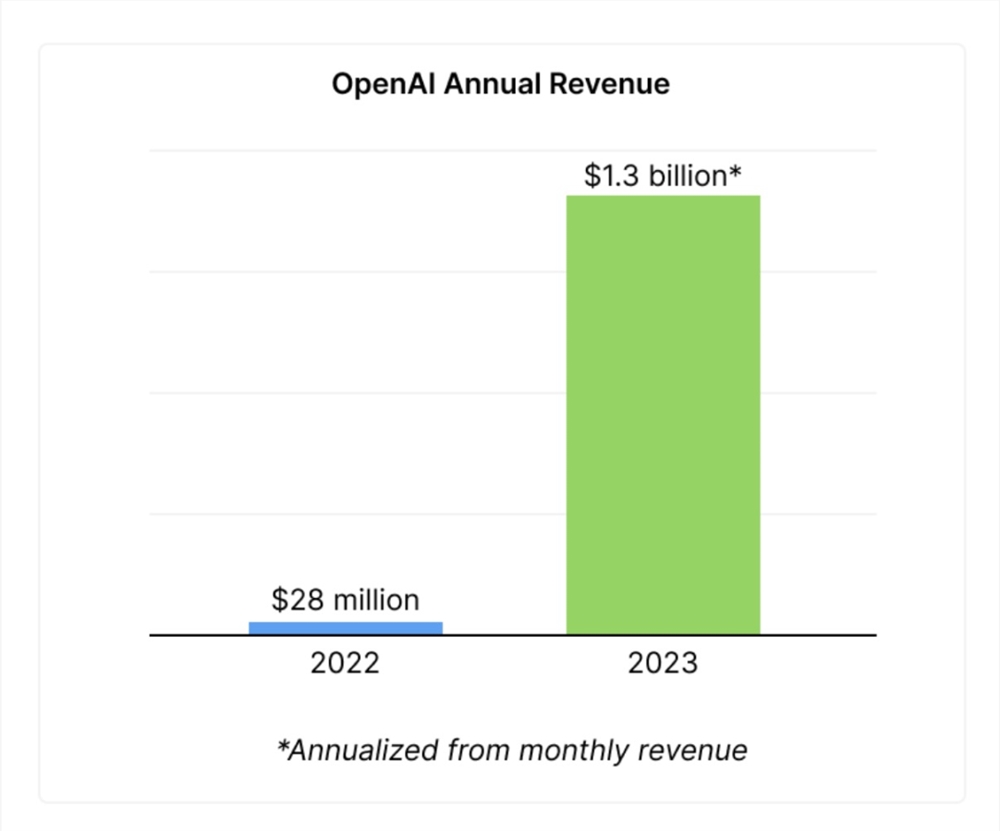Annual Revenue Surpasses $1.3 Billion: Is OpenAI on the Verge of Profitability?
-
While busy building OpenAI's new ecosystem, Altman is also highly focused on the company's revenue capabilities. According to The Information, Altman informed employees this week that OpenAI's annual revenue has now surpassed $1.3 billion. This means the company generates over $100 million per month, a 30% increase since last summer.
Notably, OpenAI's total revenue for the entire year of 2022 was just $28 million.

Since launching the paid version of ChatGPT in February, OpenAI's financial growth has been rapid. Additionally, the company announced the release of ChatGPT Enterprise in August, a commercial version of its popular conversational AI chatbot for business users.
Viewed in isolation, as a high-profile AI unicorn, OpenAI's revenue might not seem exceptionally high. However, when compared to its closest competitor, Anthropic, OpenAI's current $1.3 billion annual revenue is quite impressive.
Last week, foreign media reported that Anthropic is seeking an additional $2 billion in funding at a valuation of $20 to $30 billion. Yet, Anthropic's annualized revenue stands at just $100 million, or approximately $8 million per month.
Although both companies offer similar products, ChatGPT's market success has currently propelled OpenAI far ahead. Major corporations like Microsoft, Stripe, Volvo, and IKEA are already using OpenAI's large language models to build their own applications.
The significant revenue growth could drive up OpenAI's private valuation in upcoming tender offers. According to The Wall Street Journal, the company's total valuation may soon reach a staggering $80 to $90 billion.
Currently, despite increasing competition from Google and Anthropic, OpenAI appears to maintain its momentum. However, sustaining long-term growth may require addressing the high computational costs associated with developing and operating large language models.
Nevertheless, for a company that generated only $28 million in revenue last year, OpenAI's surge to $1.3 billion in just a few months is already a remarkable success story. The startup's continued growth highlights the disruptive potential of large language models.
Additionally, the potential of large models is also evident in their cost advantages compared to cloud infrastructure. A foreign large language model team recently experimented with GPT's fine-tuning API. They noted that a single fine-tuning run on GPT-3.5 costs $4–$12 and takes about 1–1.5 hours to fine-tune over 1 million tokens.
Meanwhile, a single p4d.24xlarge instance on AWS costs $32.77 per hour on-demand or $19.22 per hour with a 1-year reservation. Each machine is equipped with 8 Nvidia A100 GPUs. Assuming OpenAI uses only 8 GPUs to fine-tune GPT-3.5, using OpenAI is 3–8 times cheaper than renting GPUs from Amazon, without even requiring the technical expertise needed to deploy and run jobs on the cloud.
Thus, the advantage of large model providers lies not only in the quality of their models but also in their ability to offer model services at extreme scale with cost efficiency.
